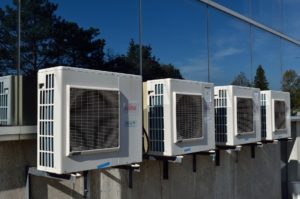Reducing Commercial Electricity Costs for HVAC Systems
The commercial electricity for HVAC systems accounts for about 50 percent of a building’s total energy consumption. Being one of the major energy costs in a manufacturing facility, it dominates the building’s peak electricity demand. As such, improving the system’s efficiency, in order to cut energy costs, should be every facility manager’s priority.
The energy consumption depends on the climate, comfort preferences, building design, insulation, the timing of use, the size of the HVAC system, heat generated by electrical equipment, and other site-specific factors.
Building owners and businesses can reduce their energy costs by combining several measures that increase an HVAC system’s efficiency while reducing the demand for heating and cooling.
Selecting the most cost-effective tariff
 The majority of the rates for commercial electricity for HVAC include the consumption and demand charges. To reduce energy costs significantly, the consumer should focus on controlling the peak demand based on data from power metering or smart meters. These meters provide a means of identifying and utilizing potential energy saving opportunities.
The majority of the rates for commercial electricity for HVAC include the consumption and demand charges. To reduce energy costs significantly, the consumer should focus on controlling the peak demand based on data from power metering or smart meters. These meters provide a means of identifying and utilizing potential energy saving opportunities.
Most commercial facilities are on an electric plan, or on a tariff that includes both the consumption and demand charges. The utilities allow consumers to choose the tariff they prefer and even provide a rate comparison to help them see how much they will pay on each of the tariffs. Since some of the tariffs are based on the usage profile, they are more suited for certain applications. As such, customers who understand the rates can save a lot by simply switching to the most economical rate.
To meet the peak demand, electricity companies must recover their underlying costs associated with generating and supplying the extra power. Since the utility must meet the maximum demand during these periods, it must invest in larger generation and transmission infrastructure. This enables them to apply peak generation, usually satisfied by expensive power generation methods, hence the higher costs.
Opportunities for reducing the commercial electricity for HVAC
In addition to selecting the best rate, there are various simple, to complex steps that consumers can take to reduce commercial electricity charges for HVAC systems. It is important to first understand what influences the energy consumption of HVAC systems.
The amount of commercial electricity required for HVAC systems depend on the design and layout of the building. In addition, the location of the system and temperature difference the between the space and its surrounding environment are important. Other factors include the internal heat generation, the type, size, and level of control of the HVAC system.
Reducing the cooling and heating needs
 Using natural ventilation, proper window coverings, windows glazing and efficient building insulation are some of the ways to reduce energy use. In addition, painting the roof white can reduce the overall temperature inside the building.
Using natural ventilation, proper window coverings, windows glazing and efficient building insulation are some of the ways to reduce energy use. In addition, painting the roof white can reduce the overall temperature inside the building.
Even with an energy efficient HVAC, the facility will spend more on energy if the electrical equipment generates more heat unnecessarily. Minimizing internal heat generation from office equipment, lighting and other electrical equipment, reduces the demand for cooling and heating, meaning that the HVAC can be smaller.
Other measures include using advanced lighting controls, turning off unused equipment, upgrading the electrical appliances and lamps to energy efficient models, reducing air leakage and improving the ventilation in office spaces.
Considerations when selecting HVAC equipment
 When selecting HVAC systems, pay attention to its design and controls. Components such as motors can impact heavily on the running costs of equipment because some are usually oversized to meet peak demands. An ideal system should have more variable speed control, inverter controls, economizers, demand controlled ventilation, advanced sensors and monitoring, as well as superior diagnostics. In addition, the system should be the appropriate size; not too small or oversized.
When selecting HVAC systems, pay attention to its design and controls. Components such as motors can impact heavily on the running costs of equipment because some are usually oversized to meet peak demands. An ideal system should have more variable speed control, inverter controls, economizers, demand controlled ventilation, advanced sensors and monitoring, as well as superior diagnostics. In addition, the system should be the appropriate size; not too small or oversized.
By controlling and running the HVAC motors at speeds based on the heating or cooling needs, consumers are able to realize energy savings of between 30 and 50 percent compared to the conventional constant speed operations. Most manufacturers prefer newer algorithm-driven smart microprocessors.
These provide a refined speed control that responds to the changing load in the building. Instead of using on and off cycling, these controls adjust the system according to the actual cooling or heating needs of the facility. More functions can be added through software add-ons as opposed to costly hardware upgrades.
Optimizing HVAC systems to minimize energy consumption
Some of the ways to optimize HVAC systems include the use of thermostats and control systems, locating the HVAC unit in the best place possible, and modifying the ventilation and distribution. These are discussed more fully below:
- The location should be further away from heat generating equipment, have sufficient airflow, and ensure shorter duct lengths and easy access. In addition, closing the doors of unconditioned or unused rooms reduces the space to heat or cool hence lowering energy consumption. To put it simple terms, you would never place your kitchen range right next to your refrigerator.
- Upgrade or replace older HVAC systems with newer energy-efficient models. In addition, existing rooftop units can be retrofitted with advanced digital economizer controls and sensors. This enables demand controlled ventilation where the economizer allows outside air into the building. This reduces the HVAC operation and energy consumption. When outside conditions are not suitable or favorable, the economizer damper reduces the ventilation position.
- Using advanced energy-efficiency controls and programmable thermostats enable the systems to automatically adjust themselves and provide the heating or cooling based on the temperature conditions inside and outside the building.
- Replace dirty filters to allow better air flow and prevent mold growth.
- Perform regular maintenance to clear debris and do visual inspections just in case there are some worn out parts, holes and other issues that affect the efficiency of the system.
HVAC energy audits
A HVAC energy audit helps in identifying the operational deficiencies, hence allowing the building manager to take the necessary measures to enhance performance. The audit is often necessary because it helps in determining the amount of energy use, maintenance and upgrade requirements.
Consumers can then reduce their energy costs by optimizing, replacing or retrofitting the HVAC system to become more energy efficient. This not only increases efficiency and reduces the amount of commercial electricity for the HVAC system, but also improves the air quality.
